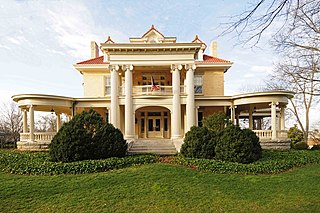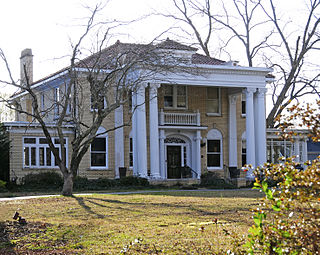
Springfield Plantation House is the oldest wood-frame house in Fort Mill, South Carolina and was the site of one of the last meetings of the Confederate cabinet. It was listed on the National Register of Historic Places in 1985.

Marsh-Johnson House, also known as Robert Johnson House, is a historic home located near Saluda, Saluda County, South Carolina. It was built about 1817, and is a two-story, log farmhouse sheathed in weatherboard. The house sits on a brick foundation and has a one-story, shed-roofed porch. It is considered one of the earliest and intact log residences in South Carolina. The house rests on massive brick piers, which are laid in Flemish bond. A one-story, shed-roofed porch with wooden foundation piers and four rough hewn tree trunks supporting the roof spans the façade. Many of the windows retain their batten shutters.

Building at 303 Saluda Avenue, also known as John C. Heslep House, is a historic home located at Columbia, South Carolina. It was built about 1917 as a two-story brick residence, then remodeled and rebuilt in the Spanish Colonial Revival style in 1927–1928. It features a low-pitched tile roof, coarse stucco walls, and cast iron balconies. Also on the property is a contributing guest house.

Olympia Mill, also known as Pacific Mill, is a historic textile mill complex located at Columbia, South Carolina. It was built in 1899, and consists of a four-story, red brick, rectangular shaped, main mill building connected to a one and two-story red brick power plant. The main building is in the Romanesque Revival style and features terra cotta detailing, large segmental arched window openings, and twin pyramidal roofed towers. The complex also includes: a one-story brick power plant auxiliary building, a one-story storage building, and two small brick one-story gatehouses.

Harden Street Substation, also known as Harden Street Fire Station, is a historic fire station located at Columbia, South Carolina. It was built in 1953, and is a two-story, rectangular brick building with a flat roof constructed in the Moderne style. It was built by the city of Columbia to house African-American firemen under white officers and maintain institutional segregation.

Pacolet Mill Office, also known as Pacolet Municipal Building and Town Hall, is a historic office building located at Pacolet, Spartanburg County, South Carolina. It built in 1908 by the Pacolet Manufacturing Company. It is a one-story, brick building with full-height basement level. It has a low-pitched hip roof with flared eaves and decorative exposed rafter tails. The roof is clad with clay Spanish tile. The site features a curving cast stone or concrete pergola added some time between 1920 and 1927. In 2004, the building became the town hall for the Town of Pacolet.

Walter Scott Montgomery House is a historic home located at Spartanburg, Spartanburg County, South Carolina. It was designed by architect George Franklin Barber and built in 1909. It is a 2+1⁄2-story, frame, yellow brick-veneer residence in the Colonial Revival style. building is of frame construction with a yellow brick veneer and a red tile roof. It features a distinctive portico and leaded glass windows. Also on the property is a one-story, reinforced concrete auto garage.

Wilson House, also known as Old Jail and Yorkville Jail, is a historic home located at York, York County, South Carolina. It is attributed to Robert Mills and was built in 1828. It is a three-story, brick building originally designed as a local jail. It features brick arches and a semi-circular fanlight. It was converted into a residence in 1853, then used as a jail during the Reconstruction Era when Federal troops imprisoned Ku Klux Klan members.

Witherspoon-Hunter House is a historic home located at York, York County, South Carolina. It was built about 1825, and consists of a two-story, front section covered by a gable roof, with a one-story L-shaped rear annex. The house is of frame construction and rests upon a raised brick basement. It features a double-tiered front portico. Also on the property is a small brick building.

Banks-Mack House is a historic home located at Fort Mill, York County, South Carolina. It was built about 1871, and enlarged and renovated in the Classical Revival style in 1910. It is a two-story, frame dwelling with a one-story, hip roofed wraparound porch. The porch once encompassed a large hickory tree that was removed because of damage from Hurricane Hugo in September 1989.

Mack-Belk House is a historic home located at Fort Mill, York County, South Carolina. It consists of a one-story rear section built in the 1860s, with a two-story, three bay, brick main block built about 1890. It features a one-story, hip roofed wraparound porch with Late Victorian design elements.

Mills House is a historic home located at Fort Mill, York County, South Carolina. It was built in 1906, and is a two-story, frame dwelling in the Classical Revival style with a slate hipped roof. The front façade features a central lower porch topped by an upper tier and flanked by side porches. All porches have Doric order columns and turned balusters.

Thornwell-Elliott House is a historic home located at Fort Mill, York County, South Carolina. It was built about 1877, and is a one-story, "L"-shaped frame dwelling in the Late Victorian style. The front façade features hip roofed porch with decorative brackets and turned balustrade.

Wilson House, also known as the Hull House, is a historic home located at Fort Mill, York County, South Carolina. It was built about 1869, and is a two-story, three bay, frame I-house with several one-story rear additions. The front façade features hip roofed porch with decorative brackets and turned balustrade in the Late Victorian style.

William Elliott White House -- also known as Elliott White Springs House—is a historic home located near Fort Mill, York County, South Carolina. It was built in 1831, and is a two-story brick house with Federal design elements. It features an elegant portico. The east wing was added in 1922, the west wing in 1936, and the greenhouse/pool in 1955. The house is one of the sites believed to have held the last full meeting of the Cabinet of the Confederate States of America. It was the home of Elliott White Springs, South Carolina textile magnate and writer of short stories in the 1920s and 1930s.

Hightower Hall is a historic home located near McConnells, York County, South Carolina. Completed in 1856, Hightower Hall is a two-story, weatherboarded frame dwelling in a vernacular interpretation of the Italianate style. The front facade features a prominent three-story tower that rises ten feet above the main roof of the house. It also has a low-pitched roof, deep eaves, decorative brackets and verandahs. Also on the property are two barns and two slave cabins.

Stokes-Mayfield House is a historic home located at Rock Hill, South Carolina. It was built in 1907, and is a two-story, frame residence with cross-gabled slate roof in the Neo-Classical style. The house features a two-story tetrastyle Corinthian order pedimented portico and a balcony with decorative iron brackets above the front door.

Rock Hill Cotton Factory, also known as Plej's Textile Mill Outlets, Ostrow Textile Mill, and Fewell Cotton Warehouse, is a historic textile mill complex located at Rock Hill, South Carolina. The mill was built in 1881, and is a two-story, 12 bay by 16 bay, brick factory. It features a three-story tower at the main entrance. A number of additions have been made to the building. The Fewell Cotton Warehouse is a one-story, brick and wood frame warehouse built before 1894.

The Lanneau-Norwood House is a historic, late 19th-century house on Belmont Avenue in Greenville, South Carolina. The house is an outstanding example of Second Empire architecture in the American South and is one of the last surviving Victorian-era homes in Greenville. The property was added to the National Register of Historic Places in 1982.

C. Granville Wyche House is a historic home located at Greenville, South Carolina. It was built in 1931, and consists of a two-story, five bay central blocked flanked by one-story balconied projections. It is of blond brick in the Italian Renaissance style with a low-pitched tile roof, wide eaves with brackets, and full-length, first floor windows. It features a massive portico with grouped classical columns and pilasters. Also on the property is a small grotto and an unpainted barn dating from the mid-1930s.
























